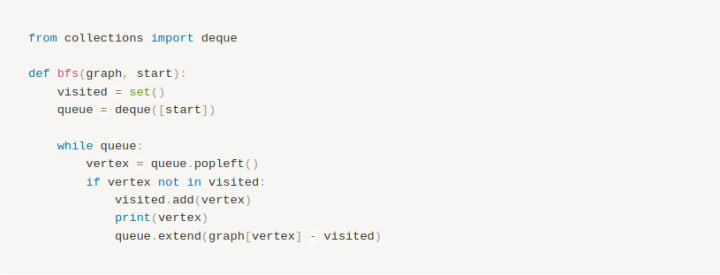Algorithms. Breadth-first Search. A Comprehensive Guide with Real-World Applications. Part 2.
Exploring the Implementation, Applications, and Example of Breadth-first Search (BFS) Algorithm

In a previous article, I covered two other popular algorithms: Binary Search and Quick Sort. If you're interested in learning more about algorithms, you might want to check out that article as well.
In computer science, graph algorithms are used to solve a variety of problems, from identifying clusters of users in social media networks to finding the shortest path between two nodes in a network. One such algorithm is Breadth-first Search (BFS), which explores all vertices in a breadth-first manner from a source vertex. In this article, we'll take a deep dive into BFS, including its implementation, real-world applications, and an example of how it works. By the end, you'll have a solid understanding of how BFS works and how you can use it in your own projects.
If you're interested in learning more about algorithms, you might want to check out the book Grokking Algorithms: An illustrated guide for programmers and other curious people.

Breadth-first Search
Breadth-first search (BFS) is a graph algorithm that explores all vertices in a breadth-first manner from a source vertex. To perform BFS, mark the source as visited, then visit all adjacent vertices and mark them as visited. BFS can solve many graph problems, including finding the shortest path between two vertices and determining graph connectivity. The time complexity of Breadth-First Search (BFS) algorithm is O(V+E), where V is the number of vertices and E is the number of edges in a graph. This means that the algorithm takes a linear amount of time proportional to the sum of the number of vertices and edges in the graph to run.
Implementation

Example
Suppose we have the following undirected graph:

We want to perform a Breadth-first Search starting from the node A.
1. We start by visiting the starting node A, and mark it as visited.
2. We add the starting node A to a queue, which initially contains only one element [A].
3. Visiting the first level of nodes:
- We have node A in the queue, so we remove it from the queue and mark it as visited.
- We check the neighbors of node A, which are B, C, and D. Since they are all unvisited, we add them to the queue and mark them as visited.
- The queue now contains [B, C, D].
4. Visiting the second level of nodes:
- We have nodes B, C, and D in the queue, so we remove them one by one and mark them as visited.
- Node B has two unvisited neighbors, which are A and E. Since node A is already visited, we add only E to the queue and mark it as visited.
- Node C has one unvisited neighbor, which is A. Since node A is already visited, we don't add any nodes to the queue.
- Node D has three unvisited neighbors, which are A, E, and F. Since node A and E are already visited, we add only F to the queue and mark it as visited.
- The queue now contains [E, F].
5. Visiting the third level of nodes:
- We have nodes E and F in the queue, so we remove them one by one and mark them as visited.
- Node E has two unvisited neighbors, which are B and G. Since node B is already visited, we add only G to the queue and mark it as visited.
- Node F has one unvisited neighbor, which is D. Since node D is already visited, we don't add any nodes to the queue.
- The queue now contains [G].
6. Visiting the fourth level of nodes:
- We have node G in the queue, so we remove it from the queue and mark it as visited.
- Node G has three unvisited neighbors, which are E, H, and I. Since node E is already visited, we add only H and I to the queue and mark them as visited.
- The queue now contains [H, I].
7. Visiting the fifth level of nodes:
- We have nodes H and I in the queue, so we remove them one by one and mark them as visited.
- Node H has one unvisited neighbor, which is G. Since node G is already visited, we don't add any nodes to the queue.
- Node I has one unvisited neighbor, which is G. Since node G is already visited, we don't add any nodes to the queue.
- The queue is now empty.
8. We have visited all nodes that are reachable from the starting node.
Real-World Applications
Social media networks, recommendation systems, and e-commerce: BFS is useful for identifying clusters of users with similar interests or behaviors, such as communities of users who interact with each other or share common topics, for finding items that are similar to each other by exploring the relationships between different products and for quickly sorting products, reviews, and other data based on user preference.
Routing algorithms and web crawlers: BFS finds the shortest path between two nodes in a network, such as the Internet Protocol (IP) routing algorithm for finding the shortest path between two hosts on the Internet and can crawl and index websites, which is useful for building search engine indexes or web archives.
Pathfinding algorithms and game AI: BFS finds the shortest path between two points in a grid or a map, such as two cities on a map and searches for a winning move in a game by exploring all possible moves, such as in a game of chess.

Conclusion
In this article, I took a deep dive into Breadth-first Search (BFS), a graph algorithm used to explore all vertices in a breadth-first manner from a source vertex. I covered its implementation, real-world applications, and an example of how it works. BFS can be used to solve many graph problems, including finding the shortest path between two vertices, determining graph connectivity, and identifying clusters of users in social media networks. It has applications in routing algorithms, web crawlers, recommendation systems, and game AI. By the end of this article, you should have a solid understanding of how BFS works and how you can use it in your own projects. If you're interested in learning more about algorithms, you might want to check out the book "Grokking Algorithms: An illustrated guide for programmers and other curious people."
In the next article, I will cover another popular algorithm, Dijkstra's algorithm, which is used to find the shortest path between two nodes in a weighted graph.
About the Creator
Alex Cadence
The point is to create. Start today.






Comments
There are no comments for this story
Be the first to respond and start the conversation.